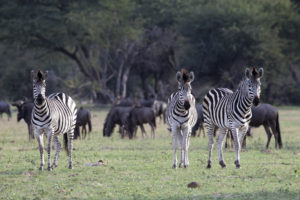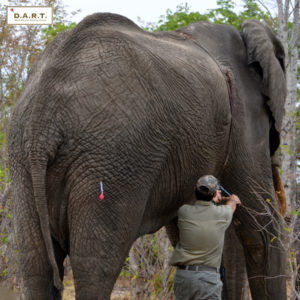How lovely it was to see the park looking so lush on a recent trip to Hwange. Some early widespread rain has clothed the veld in glorious shades of green. Delicate new Mopane leaves, waxy and glistening, range in colour from pale yellow and orange to deep russet red, and some of the teak trees are already bearing pretty pinky-purple blooms. There are pools of natural water lying in various dips and hollows, and the pans are filling up nicely aided by the solar pumps which have been installed at most water holes and have proved extremely successful so far.
Animals have largely dispersed, but we did see some lovely herds of elephant enjoying a drink and a splashy mud bath, a herd of buffalo three hundred strong relishing new green grass in the vlei, two large herds of roan antelope their coats sleek and shining, and the usual variety of kudu, wildebeest, sable, zebra, giraffe, reed buck, dainty little steenbok, black backed jackals and of course lots of impala, many with tiny, newborn fawns on long, gangly legs. Cats proved elusive, but we were rewarded with a sighting of an awesome male lion at Ngamo and a beautiful pair of lionesses hunting at Backpan. We spied one of the male lions of the coalition near Main Camp waving his paw in the air some distance from the road, but irritatingly, he refused to lift his head or show his face. Tortoises of various sizes ambling through the bush were a delight, as were warthogs with litters of cute, miniature piglets. And although we didn’t see them, hyena were frequently heard whooping at night and in the early dawn.
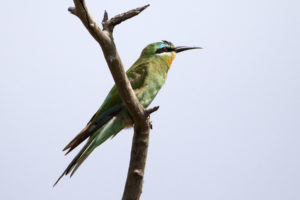
Image David Dell
With the migrants back in numbers, birdlife in the park is spectacular. Several pairs of pied Avocets at Salt Pan and another pair at Deteema are causing excitement in avian circles. Special to see are blue cheeked bee-eaters at Shumba, and we found a glorious painted snipe near Masuma Dam. Rufous-naped larks may be found singing on tree stumps all up and down the roadside. Black and yellow billed kites by the hundred swoop down on hapless frogs, and many smaller raptors are frenziedly feasting on termites – a sure sign of summer in Hwange.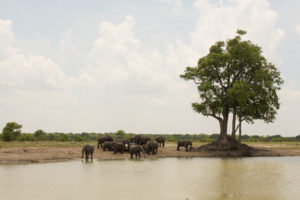
The water situation throughout the park has been good throughout the year. Gary experienced a few anxious days at the end of the dry season when a cloudy spell of weather meant the solar pumps produced scant water. With temperatures soaring, asides from water to drink, elephants need to bathe to avoid overheating, and the levels in the pans quickly dropped. The situation resolved with the onset of some rain when the pachyderms headed towards the south of the park in numbers, and the solar pumps quickly replenished water levels. Friends of Hwange has so far drilled a total of 13 new boreholes and installed over thirty solar pumps throughout the Main Camp region. Most recently, WWF assisted with funds to equip five pans in the far south of the park. These pans are very important as they are the first in line when parched elephants travel northwards at the onset of the dry season. However, Mbazo was found to need a new borehole as was Secheche, so FOH stepped in to fund these. It is a priority to equip these new holes asap, and as ongoing maintenance is also a constant concern, fund raising remains a top priority.
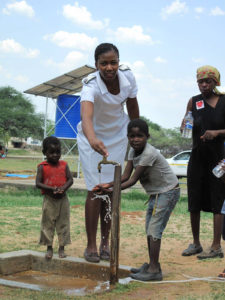 We acknowledge the importance of providing some assistance to the park’s staff and villagers living close to the boundary of the park. In the past year, generous help has enabled us to provide a comprehensive range of drugs and medical supplies for the clinic in Main Camp. This is the hub from which Sister Mhlanga travels to outlying stations, covering an area in the west of Zimbabwe from Victoria Falls to Beit Bridge. In addition, we have installed a new solar pump at Mabale which provides water for the clinic and school. FOH together with Wilderness also funded a solar pump at Mtshayeli recently which supplies the clinic, school and whole community and their livestock with clean water. Asides from the enormous goodwill engendered, this prevents the need for the villagers to drive their livestock into the park for water and grazing.
We acknowledge the importance of providing some assistance to the park’s staff and villagers living close to the boundary of the park. In the past year, generous help has enabled us to provide a comprehensive range of drugs and medical supplies for the clinic in Main Camp. This is the hub from which Sister Mhlanga travels to outlying stations, covering an area in the west of Zimbabwe from Victoria Falls to Beit Bridge. In addition, we have installed a new solar pump at Mabale which provides water for the clinic and school. FOH together with Wilderness also funded a solar pump at Mtshayeli recently which supplies the clinic, school and whole community and their livestock with clean water. Asides from the enormous goodwill engendered, this prevents the need for the villagers to drive their livestock into the park for water and grazing.
Snaring for bush meat is an ongoing problem. We have managed to help in removing snares off several wild dogs, elephant, buffalo, lion, hyena and various antelope. It is an immense relief to be able to assist when a report comes in of an animal in distress, and we thank Paul de Montille of D.A.R.T for his time and efforts in finding and treating affected wildlife, often at considerable personal risk to his own safety.
As always, we are extremely grateful for all donations large and small – every dollar really does help to make a difference. Without this constant support, we cannot continue our vital work.
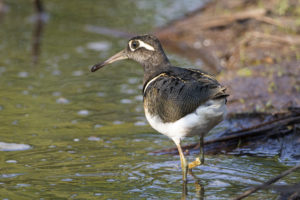
Image David Dell

